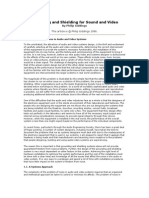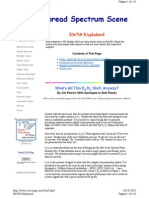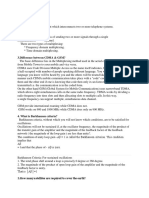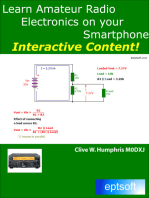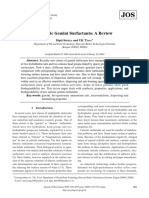What Is Ecio and Ebno
What Is Ecio and Ebno
Uploaded by
dinjhbCopyright:
Available Formats
What Is Ecio and Ebno
What Is Ecio and Ebno
Uploaded by
dinjhbOriginal Title
Copyright
Available Formats
Share this document
Did you find this document useful?
Is this content inappropriate?
Copyright:
Available Formats
What Is Ecio and Ebno
What Is Ecio and Ebno
Uploaded by
dinjhbCopyright:
Available Formats
What is Ec/Io (and Eb/No)?
- telecomHall
Page 1 of 17
telecomHall
Home Hunter Get Hunter Tips Course
Home
Site Map
Register
Sign In
enter search terms
Search
Groups
Forums
Jobs
Events
Community
About
What is 0 dBm? What is VSWR? Parameter Timing Advance (TA) What is RTWP? What is HSN and MAIO in GSM? What is Rake Receiver? What is Frequency Hopping - FHSS? What is Modulation? What is RF Drive Test (Testing)? OSI 7 Layers Model What is Antenna? What is Cellular Field Test Mode? What is Ec/Io (and Eb/No)? Goodbye IPv4... Hello IPv6! What is MIMO? How to Run a RF Site Survey (Tips and Best Practices)
What is Ec/Io (and Eb/No)?
If someone asks you "Which Signal Level for good call quality: -80 dbm or -90 dBm?"
Beware, if you respond quickly, you might end up missing. This is because the correct answer is ... it depends! The Signal Strength is a very important and essential measure for any technology (GSM, CDMA, UMTS, LTE, etc.). However, it is not the only one: let's talk a little today about another magnitude, equally important: the Signal Noise Ratio. Although this ratio is of fundamental importance to any cellular system, is not well understood by many professionals. On the opposite side, professionals with a good understanding of this ratio are able for example, to correctly assess the RF links, and also to perform more extensive optimizations, obtaining the best possible performance of the system. So, let's see a little about it?
Eb and No
To begin, we define the basic concepts of Eb and No. They are basic for any digital communication system, and generally we talk about it when we deal with Bit Error Rate and also Modulation techniques. Simply put:
http://www.telecomhall.com/what-is-ecio-and-ebno.aspx
1/31/2012
What is Ec/Io (and Eb/No)? - telecomHall
Page 2 of 17
IP Packet switching in Telecom - Part 1
Eb: Bit Energy. It represents the amount of energy per bit. No: Noise Spectral Density. Unit: Watts/Hz (or mWatts/Hz) Which brings us to the classic definition of Eb/No: Eb/No: Bit Energy on the Spectral Noise Density. Unit: dB It did not help much, does it? Do not worry. Indeed, only with the theoretical definition is still very difficult to see how this ratio is used, or how it can be measured. But okay, let's walk a little further.
Okay, so how is Eb/No measured?
To understand how this ratio can be measured, let's imagine a simple digital communication system.
The ratio Eb/No is measured at the receiver, and serves to indicate how strong the signal is. Depending on the modulation technique used (BPSK, QPSK, etc.) we have different curves for Bit Error Rate x Eb/No. These curves are used as follows: for a certain RF signal, which is the bit errors rate that I have? Is this bit error rate acceptable for my system? Whereas the gain that digital has, then we can set a minimum criterion of signal to noise ratio, in order to have each service (Voice/Data) operating acceptably.
http://www.telecomhall.com/what-is-ecio-and-ebno.aspx
1/31/2012
What is Ec/Io (and Eb/No)? - telecomHall
Page 3 of 17
In other words, we can theoretically determine how the performance would be for the digital link. Note: it is worth remembering here that this is a very complex subject. As always, we try to introduce to you the most simplified possible through the use of examples and simple concepts. Okay? For example, a concept that could be explored here - since we are talking about digital communication system - is the Noise Figure. But we do not want to repeat here all the theory explained in the University. Nor was it to have mentioned the noise figure here, but as we talked about it, just understand as a noise level that every receiver has, and that it is due to the process of amplification and processing of signal. Concepts like this, and other even more complex, can be studied, if you wish. But now, let's continue with our signal to noise ratio.
Eb/No -> Ec/Io
The concept of Eb/No applies to any digital communication system. But today we are talking specifically to Ec/Io, which is a measure of evaluation and decisions of CDMA and UMTS. Note: all the technology uses signal-interference ratio. For example, in GSM, we use C/I.
http://www.telecomhall.com/what-is-ecio-and-ebno.aspx
1/31/2012
What is Ec/Io (and Eb/No)? - telecomHall
Page 4 of 17
As we are speaking of codes, it becomes easier to understand the concepts by observing a simplified diagram of Spread Spectrum Modulation. In red, in transmitter have a narrowband signal with data or voice modulated. This signal is spread and transmitted. And spreads through the middle (air). In the receiver, the signal is despread - using the same sequence that was spread - and thus recovering the base narrowband signal.
To proceed, we must know some more definitions. However, this point is quite delicate, as we enter a conceptual area where we have differences between authors, differences in translations/countries, where differences in technologies are applied, etc.. Let's try to define in a generic way, and only the main. No: Spectral Density of Noise; Noise generated by the RF components of the system, the air, among others. Io: Interference is the Broadband; Interfering co-channel, including yourself setor. E: is the signal (average) energy - do not confuse it with the sinal (average) power. b, c, s. ..: Energy are the power points in time, therefore related to the measure or 'length' of the time (the average power is independent of time ). Hence it comes Eb, Ec and Es, respectively relating to Bit Chip and Symbol in different times. Note: With these concepts, several formulas can be derived with different numerators and denominators. For example, Es = Eb * k, where k = number of bits per symbol. In QPSK modulation, where k = 2, Es = 2 * Eb. And the derivations of formulas can reach far more complex equations, such as the definitions of capacity of an AWGN channel, and further
http://www.telecomhall.com/what-is-ecio-and-ebno.aspx
1/31/2012
What is Ec/Io (and Eb/No)? - telecomHall
Page 5 of 17
deductions for equivalences (Ec/No, Eb/Nt, etc. ...). Again, it is not our purpose here today. We only mention a few concepts, related. Then come back to the practical level - noting that theoretical approaches can be done more easily later, after the basics are understood. So let's keep today in ratios most common: Eb/No and Ec/Io. As we defined Eb/No is the Average Energy of a bit signal, on the Spectral Density of Noise. It is primarily a parameter related to the manufacturer for different bearers (based on the channel model). But it can also vary with the environment (urban, rural, suburban), speed, diversity, use of power control, application type, etc.. And now we can begin to define Ec/Io, one of the most important systems in CDMA and UMTS. Note: An important observation is that often when we refer to Ec/Io, we are actually referring to Ec/(Io + No). What happens is that for practical purposes, we only have Ec/Io, because the interference is much stronger and the noise can be neglected. Otherwise: for CDMA interference is like a noise, then both can be considered the same thing. Okay, let's stop with the issues and concepts, and talk a little about the values of these indicators and their use in practice.
Eb/No Positive and Ec/Io Negative?
In terms of values, and talking logarithmicly, if any ratio is less than 1, then the value is negative. If greater than 1, positive. We have Ec/Io in the air, which is spread across the spectrum: then we have negative value to the ratio of energy on the total noise (the energy is lower than the Total Interference). It is measured at the input of receiver (NodeB, UE, etc). Regarding Eb/No, it is in the baseband after despreading and decoded only for one user - then we have a positive amount of energy over the total noise. It is measured at the output of receiver (NodeB, UE, etc).
Why should we use Ec/Io?
A more natural question would be: why we can not simply use the Signal Strength measured by the mobile as a guide for operations such as handover? The answer is simple: the measured signal level corresponds to the Total RF power - All cells that the mobile sees.
http://www.telecomhall.com/what-is-ecio-and-ebno.aspx
1/31/2012
What is Ec/Io (and Eb/No)? - telecomHall
Page 6 of 17
So we need another quick and simple measure that allows us to evaluate the contribution of each sector individually. We used to measure the pilot channel signal of each sector to assess the quality: if the level of the pilot is good, then also are good levels for the traffic channels for our call in this sector. Likewise, if the pilot channel is degraded, so will the other channels (including traffic) be, and it is best to avoid using the traffic channels in this sector. UMTS and CDMA systems, we have a pilot channel, some other control channels such as paging, and traffic channels. The Ec/Io varies with several factors, such as the Traffic Load and and RF Scenario. Of course, the Ec/Io is the final composition of all these factors simultaneously (Composite Ec/Io), but it's easier to understand talking about each one separately.
Change in Ec/Io according to the Sector Traffic Load
Each sector transmits a certain power. Suppose in our example we have a pilot channel power setting of 2 W, and a power of other control channels also fixed at 2 W. To make it easier to understand, we calculate the Ec/Io (pilot channel power to total power) of this sector in a situation where we have no busy traffic channel (0 W).
http://www.telecomhall.com/what-is-ecio-and-ebno.aspx
1/31/2012
What is Ec/Io (and Eb/No)? - telecomHall
Page 7 of 17
Thus we have: Ec = 2 W Io = 0 + 2 + 2 = 4 W Ec/Io = (2/4) = 0.5 = -3 dB Now assume that several traffic channels are busy (eg use 6 W for traffic channels). This is a situation of traffic load, we'll see how is Ec/Io.
Ec = 2 W Io = 2 + 2 + 6 = 10 W Ec/Io = (2/10) = 0.2 = -7 dB Conclusion: As the traffic load in the sector increases, the Ec/Io worsens.
http://www.telecomhall.com/what-is-ecio-and-ebno.aspx
1/31/2012
What is Ec/Io (and Eb/No)? - telecomHall
Page 8 of 17
Change in Ec/Io according to the scenario RF
According to the RF scenario - a single server sector, some or many servers sectors - we can also take various measures to Ec/Io. Considering first a situation without external interference, with only one server sector (dominant), the ratio Ec/Io is about the same initially transmitted.
Ec/Io = (2/8) = 0.25 = -6 dB Whereas a signal coming from this sector in the mobile at level of -90 dBm (Io = -90 dBm), we have Ec = -90 dBm + (- 6 db) = -96 dBm.
Let us now consider another situation. Instead of one, we have five sectors signal arriving at the mobile (for simplicity, all with the same level of -90 dBm).
http://www.telecomhall.com/what-is-ecio-and-ebno.aspx
1/31/2012
What is Ec/Io (and Eb/No)? - telecomHall
Page 9 of 17
Now have Io = -83 dBm (which is the sum of five signals of -90 dBm). And the power of our pilot channel remains the same (Ec = -96 dBm). Thus: Ec/Io = -96 - (-83) = -13 dB Conclusion: As many more sectors serves the mobile, the Ec/Io worsens.
This situation where we have many overlapping sectors, and with the same level of signal is known as Pilot Pollution - the mobile sees them all at once - each acting as interferer to each other. The solution in such cases is to eliminate unwanted signals, by setting power parameters or physical adjustments (tilt, azimuth), leaving just dominant signals which should exist at this problematic place.
http://www.telecomhall.com/what-is-ecio-and-ebno.aspx
1/31/2012
What is Ec/Io (and Eb/No)? - telecomHall
Page 10 of 17
Okay, and what are typical values?
We have seen that for CDMA and UMTS systems, the measurement of Ec/Io which is very important in the analysis, especially in handover decisions. And now also understand the measure Ec/Io as the ratio of 'good' energy over 'bad' energy, or 'cleaness' of signal. But what are the practical values? The value of Ec/Io fluctuates (varies), as well as any wireless signal. If the value starts to get too low, you start to have dropped calls, or can not connect. But what then is a good range of Ec/Io for a sign? In practical terms, values of Ec/Io for a good evaluation of the network (in terms of this indicator) are shown in the diagram below.
A composite Ec/Io > - 10 db is a reasonable value to consider as good. Note: See we are talking about negative values, and considering them 'good'. In other words, we are saying that energy is below the Noise (and still have a good situation). This is a characteristic of the system itself, and Ec/Io 'most negative' or 'less negative' is going to allow assessment of the communication. In situations where Ec/Io is very low (high negative number), and the signal level too (also high negative number), first we need to worry in enhancing the weak signal. Another typical situation: if the measured Ec/Io is very low, even if you have a good signal level, you can not connect, or the call will drop constantly. I hope you've managed to understand how the Ec/Io is important for CDMA and UMTS. Note, however, that this matter is very complex, and supplementary reading - books and internet - can further help you become an expert on the subject. Anyway, the content displayed serves as an excellent reference, especially if you're not familiar with the concept of signal over noise for CDMA and UMTS.
http://www.telecomhall.com/what-is-ecio-and-ebno.aspx
1/31/2012
What is Ec/Io (and Eb/No)? - telecomHall
Page 11 of 17
And the Signal to Noise Ratio for other technologies?
The ratio Ec/Io is the most commonly used to assess the condition of energy over interference, but applies only in technologies that use codes (Ec). But the concepts understood here to CDMA and UMTS are very similar - apply - for any technology, eg GSM, where we use the C/I. Anyway, this is a topic for another tutorial, we saw today Ec/Io.
Conclusion
Today we had a brief introduction on the Ec/Io ratio, a measurement for decisions in CDMA and UMTS, and used togheter with the measured Signal Strength. We have seen that it represents the ratio of signal energy within the duration of a chip of the pilot channel, on the Spectral Density of Noise + Interference. This is a very important measure, which somehow ignores the overall strength of the signal, and focuses on how best to evaluate the pilot channel signal is desired, in relation to noise that interferes with it. Returning to our original question: A strong signal level does not necessarily indicate an strong Ec/Io: it depends on the level of interference.
Tweet10
http://www.telecomhall.com/what-is-ecio-and-ebno.aspx
1/31/2012
What is Ec/Io (and Eb/No)? - telecomHall
Page 12 of 17
Live Traffic Feed
See your visitors in RealTime! Get the Free Live Traffic Feed Get Feedjit Now! A visitor from Santa Clara, California viewed "What is HSN and MAIO in GSM? telecomHall" 3 mins ago A visitor from Santa Clara, California viewed "What is HSN and MAIO in GSM? telecomHall" 4 mins ago A visitor from Santa Clara, California viewed "What is HSN and MAIO in GSM? telecomHall" 4 mins ago A visitor from Santa Clara, California viewed "What is HSN and MAIO in GSM? telecomHall" 5 mins ago A visitor from Santa Clara, California viewed "What is HSN and MAIO in GSM? telecomHall" 5 mins ago A visitor from Santa Clara, California viewed "What is HSN and MAIO in GSM? telecomHall" 5 mins ago A visitor from Santa Clara, California viewed "What is HSN and MAIO in GSM? telecomHall" 6 mins ago A visitor from Santa Clara, California viewed "What is HSN and MAIO in GSM? telecomHall" 7 mins ago A visitor from Covington, Georgia viewed "What is RF Drive Test (Testing)? telecomHall" 9 mins ago A i it f S t Cl C lif i i d
http://www.telecomhall.com/what-is-ecio-and-ebno.aspx
1/31/2012
What is Ec/Io (and Eb/No)? - telecomHall
Page 13 of 17
Login This blog post All blog posts Subscribe to this blog post's comments through...
Add t Add to My Yahoo!
Add to Google Add t
RSS Icon
RSS Feed
Subscribe via email
Email Address
Follow the discussion
Subscribe
Comments (8)
Logging you in... Close Login to IntenseDebate Or create an account Username or Email: Password:
Forgot login?
http://www.telecomhall.com/what-is-ecio-and-ebno.aspx
1/31/2012
What is Ec/Io (and Eb/No)? - telecomHall
Page 14 of 17
OpenID Cancel Login Close
WordPress.com
Username or Email: Password:
Lost your password? Cancel Login Close Login with your OpenID Or create an account using OpenID OpenID URL: http:// Back Cancel Login Dashboard | Edit profile | Logout Logged in as Sort by: Date Rating Last Activity 0 Vote up Vote down
fitra.wiriadinata 34 weeks ago Good explanation... Reply 0 Vote up Vote down
Kami 33 weeks ago
http://www.telecomhall.com/what-is-ecio-and-ebno.aspx
1/31/2012
What is Ec/Io (and Eb/No)? - telecomHall
Page 15 of 17
Really a good try ... Reply 0 Vote up Vote down
adlet 32 weeks ago in russion plzzzz Reply +1 Vote up Vote down
Shahid Saleem 31 weeks ago I have Five year of telecom professional Experience in field of GSM,WIMAX&UMTS. For upgradation of my knowledge. I want to join this forum. Reply 0 Vote up Vote down
qtip 18 weeks ago Excellent to point explanation. Thank you. Reply 0 Vote up Vote down
yem 11 weeks ago baguih dok ada Reply 0 Vote up Vote down
Amir 8 weeks ago love you for such posts :) Reply
http://www.telecomhall.com/what-is-ecio-and-ebno.aspx
1/31/2012
What is Ec/Io (and Eb/No)? - telecomHall
Page 16 of 17
0 Vote up Vote down
Ayman 6 days ago Very good. keep going boss Reply
Post a new comment
Enter text right here!
Comment as a Guest, or login: Login to IntenseDebate Login to WordPress.com Login to Twitter Login to OpenID
Tweet this comment
Connected as (Logout) Email (optional) Not displayed publicly. Name Email Website (optional)
Displayed next to your comments.
Not displayed publicly.
http://www.telecomhall.com/what-is-ecio-and-ebno.aspx
1/31/2012
What is Ec/Io (and Eb/No)? - telecomHall
Page 17 of 17
If you have a website, link to it here. OpenID URL http:// Comment as a Guest or login using OpenID Submit Comment Subscribe to None Comments by IntenseDebate
Site Map | Printable View | 2008 - 2012 telecomHall Powered by mojoPortal | HTML 5 | CSS | Design by styleshout
http://www.telecomhall.com/what-is-ecio-and-ebno.aspx
1/31/2012
You might also like
- Vulnhub - SAHUDocument10 pagesVulnhub - SAHUJuan Pablo Gonzalez CameraNo ratings yet
- Bad EcNoDocument4 pagesBad EcNosurvivalofthepoly100% (1)
- Noise Optimization in Sensor Signal Conditioning Circuit Part IDocument37 pagesNoise Optimization in Sensor Signal Conditioning Circuit Part Iyzhao148No ratings yet
- Ounding and Shielding For Sound and Video PDFDocument37 pagesOunding and Shielding For Sound and Video PDFMoyGar2014No ratings yet
- Isro, Barc Interview QuestionsDocument7 pagesIsro, Barc Interview QuestionspuppykNo ratings yet
- Cylinder Gas Rack Design Report - RR2-1Document34 pagesCylinder Gas Rack Design Report - RR2-1Aditya JainNo ratings yet
- Unit 2 - Input and Output Devices PDFDocument9 pagesUnit 2 - Input and Output Devices PDFflorinciriNo ratings yet
- What Is Ec - Io (And Eb - No) - TelecomHallDocument8 pagesWhat Is Ec - Io (And Eb - No) - TelecomHallromansoyNo ratings yet
- HTTP WWW Telecom Hall Com What Is Ecio and Ebno AspxpDocument9 pagesHTTP WWW Telecom Hall Com What Is Ecio and Ebno AspxpghepardooNo ratings yet
- EcNo RadioDocument10 pagesEcNo RadiodanyforexNo ratings yet
- Statistics Categories: Eb/No Ec/Io X Processing GainDocument11 pagesStatistics Categories: Eb/No Ec/Io X Processing GainskafleNo ratings yet
- Diff Between EcNo, EbNo &EcIo Plus RTWPDocument12 pagesDiff Between EcNo, EbNo &EcIo Plus RTWPNeoRa Ndivo RamsNo ratings yet
- What Is Ec/Io (And Eb/No) ?: Statistics CategoriesDocument11 pagesWhat Is Ec/Io (And Eb/No) ?: Statistics CategoriesSARVESHNo ratings yet
- Presentation Basic EcIo and EcNoDocument14 pagesPresentation Basic EcIo and EcNoJikuNo ratings yet
- 05 Air Interface OptimizationDocument26 pages05 Air Interface Optimizationgh_jazaniNo ratings yet
- RF NotesDocument156 pagesRF NotesAnieKhan100% (1)
- Eb Vs No ExplainedDocument10 pagesEb Vs No Explaineddavid_benavidez_3100% (1)
- ReportDocument24 pagesReportgirithik14No ratings yet
- Smit 03 EfficientDocument6 pagesSmit 03 EfficientAsitha DharmadasaNo ratings yet
- Onthedownlinkcapacityof LTEcellDocument7 pagesOnthedownlinkcapacityof LTEcellMazen ShibanNo ratings yet
- RSCP and Ecno RTWPDocument7 pagesRSCP and Ecno RTWPDayanidhi PandaNo ratings yet
- 5G NR Beam Managment in GernalDocument22 pages5G NR Beam Managment in Gernalturi313No ratings yet
- Link Budgets: Intuitive Guide To Principles of CommunicationsDocument23 pagesLink Budgets: Intuitive Guide To Principles of CommunicationsDhie_DhieNo ratings yet
- Cellonics Technology Seminar ReportDocument23 pagesCellonics Technology Seminar Reportnm gunasekharNo ratings yet
- What Is Ec/Io, How It Is Varied With Traffic, Why Ec/Io Is Always NegativeDocument2 pagesWhat Is Ec/Io, How It Is Varied With Traffic, Why Ec/Io Is Always NegativeAvinash KumarNo ratings yet
- TDK EMC TechnologyDocument122 pagesTDK EMC Technologycarlosmandopinto100% (1)
- TDK Emc OutlineDocument9 pagesTDK Emc OutlineSafwen SelmiNo ratings yet
- What'S Difference Between RSCP, Rssi and Ecno?: Some Facts About HsdpaDocument25 pagesWhat'S Difference Between RSCP, Rssi and Ecno?: Some Facts About HsdpaHabeeb MustafaNo ratings yet
- VSWRDocument5 pagesVSWRAltafNo ratings yet
- Splitter and CombinerDocument9 pagesSplitter and CombinerAltafNo ratings yet
- Application Notes - Correcting Mistimed I/O Page 1 of 2Document2 pagesApplication Notes - Correcting Mistimed I/O Page 1 of 2nsbmuraliNo ratings yet
- 3G QuestionsDocument11 pages3G QuestionsHumayun KabirNo ratings yet
- 2W 4W SystemDocument7 pages2W 4W SystemmaanbsNo ratings yet
- RSCP & Ec - Io - 3G - Telecom TrafficDocument4 pagesRSCP & Ec - Io - 3G - Telecom TrafficAnthony Tiriba100% (1)
- VSWR-TA-E&M Tilt-Modulation-RSSI-DCRDocument34 pagesVSWR-TA-E&M Tilt-Modulation-RSSI-DCRChaudary Imran100% (1)
- 3G QuestionDocument7 pages3G QuestionOmran QureshiNo ratings yet
- HearignAid English V1.1Document9 pagesHearignAid English V1.1vigyanashramNo ratings yet
- C-N and Eb-No Measurement TutorialDocument4 pagesC-N and Eb-No Measurement Tutorialsakura31979100% (1)
- Eb/N0 Explained: What's All This E /N Stuff, Anyway?Document4 pagesEb/N0 Explained: What's All This E /N Stuff, Anyway?Mohammad MoniruzzamanNo ratings yet
- FCC Antenna Factors PDFDocument6 pagesFCC Antenna Factors PDFpablocotan100% (1)
- LAN Cable TestingDocument16 pagesLAN Cable TestinglantordoNo ratings yet
- Telecommunications, The Internet, and Wireless Technology Chapter Seven (10 Ed)Document48 pagesTelecommunications, The Internet, and Wireless Technology Chapter Seven (10 Ed)ParamkusamNo ratings yet
- Telecomhall: What Is Antenna Electrical and Mechanical Tilt (And How To Use It) ?Document14 pagesTelecomhall: What Is Antenna Electrical and Mechanical Tilt (And How To Use It) ?Jitendra MishraNo ratings yet
- Scales and Decibel ScalesDocument4 pagesScales and Decibel ScalesManish KumarNo ratings yet
- InterviewDocument24 pagesInterviewCatherine RyanNo ratings yet
- 5.how Many Satellites Are Required To Cover The Earth?Document6 pages5.how Many Satellites Are Required To Cover The Earth?Suman BhattacharyyaNo ratings yet
- RF Desgn - NotesDocument117 pagesRF Desgn - NotesnatashaNo ratings yet
- Posted by Gary Fenical On March 1, 2014 in Basics - Leave A ResponseDocument9 pagesPosted by Gary Fenical On March 1, 2014 in Basics - Leave A Responsekprk414No ratings yet
- C - I To Ber To FerDocument5 pagesC - I To Ber To FerAhmad AsgharNo ratings yet
- FinalDocument16 pagesFinalKrishna DhootNo ratings yet
- Cellonics DocumentDocument19 pagesCellonics Documentsananda4u100% (1)
- EC8491 CT Notes Full - by WWW - EasyEngineering.net 4 PDFDocument152 pagesEC8491 CT Notes Full - by WWW - EasyEngineering.net 4 PDFvijay kumarNo ratings yet
- 3G QuestionDocument7 pages3G Questionswagatam goraiNo ratings yet
- Energy Efficiency in Communications and NetworksDocument150 pagesEnergy Efficiency in Communications and NetworksJosé RamírezNo ratings yet
- Cellonics Technology: Dept of Ece, RcewDocument24 pagesCellonics Technology: Dept of Ece, Rcewk. akhilaNo ratings yet
- GSM Link BudgetDocument34 pagesGSM Link BudgetJnanendra KhatiwadaNo ratings yet
- Prepared By: IBT Instructor Training - April 2012Document11 pagesPrepared By: IBT Instructor Training - April 2012Buchi SurendraNo ratings yet
- AP2402630 EMC Guidelines 1Document63 pagesAP2402630 EMC Guidelines 1Tuấn Nguyễn TrungNo ratings yet
- Unit-IV-20-05-21 (1)Document17 pagesUnit-IV-20-05-21 (1)kushalmendra001No ratings yet
- RF Analog Impairments Modeling for Communication Systems Simulation: Application to OFDM-based TransceiversFrom EverandRF Analog Impairments Modeling for Communication Systems Simulation: Application to OFDM-based TransceiversNo ratings yet
- Amateur Radio Electronics on Your MobileFrom EverandAmateur Radio Electronics on Your MobileRating: 5 out of 5 stars5/5 (1)
- Note On GPS CoordinateDocument2 pagesNote On GPS CoordinatedinjhbNo ratings yet
- Get BSC DumpDocument8 pagesGet BSC DumpdinjhbNo ratings yet
- ZXSDR FDD R8882 Product DescriptionDocument29 pagesZXSDR FDD R8882 Product DescriptionEr Biswajit Biswas100% (6)
- ZXSDR FDD R8882 Product DescriptionDocument29 pagesZXSDR FDD R8882 Product DescriptionEr Biswajit Biswas100% (6)
- Infonetics in Building Wireless White Paper PDFDocument23 pagesInfonetics in Building Wireless White Paper PDFdinjhbNo ratings yet
- Netact Tutorial PDFDocument9 pagesNetact Tutorial PDFIevgen Volvach100% (2)
- New RRU Introduction V1.2Document12 pagesNew RRU Introduction V1.2dinjhbNo ratings yet
- Fractional Load PlanningDocument1 pageFractional Load PlanningdinjhbNo ratings yet
- Netact Tutorial PDFDocument9 pagesNetact Tutorial PDFIevgen Volvach100% (2)
- Dapus 2Document6 pagesDapus 2Leni NurilNo ratings yet
- WF 56 H 9100 ADocument42 pagesWF 56 H 9100 AIsidro Mendoza100% (1)
- Annex A - Regional CORE PAPsDocument14 pagesAnnex A - Regional CORE PAPsDave Briones IINo ratings yet
- 4G Lite Operator ManualDocument313 pages4G Lite Operator ManualDaniel Suescun MariñoNo ratings yet
- (040420) Developing Business Case PPT GroupDocument22 pages(040420) Developing Business Case PPT GroupAndi Yusuf MasalanNo ratings yet
- PNLE Practice Test 250 Items With RationalizationDocument76 pagesPNLE Practice Test 250 Items With RationalizationMARY ROSE P. REMENTIZONo ratings yet
- WalkingDocument1 pageWalkingviji senthilkumarNo ratings yet
- T T 253019 My Family CrosswordDocument2 pagesT T 253019 My Family CrosswordJewel AhmedNo ratings yet
- Evaluation of Area Traffic Management Measures Using Microscopic Simulation ModelDocument10 pagesEvaluation of Area Traffic Management Measures Using Microscopic Simulation ModelLokesh KNo ratings yet
- Characters Distribution and Types of BrassicaseaeDocument11 pagesCharacters Distribution and Types of Brassicaseaesamuel mainaNo ratings yet
- 06 JOS ShuklaDocument10 pages06 JOS ShuklaDeepikaNo ratings yet
- Internship Report On Standard BankDocument53 pagesInternship Report On Standard BankRefat Dedar100% (3)
- Exit Exam Course For Management DepartmentDocument9 pagesExit Exam Course For Management DepartmentLegese Tusse100% (4)
- 06 Chapter 3Document66 pages06 Chapter 3sanjeevNo ratings yet
- Analysis of Jetty Platform Due To Earthquake and Storm Wave (Batam Sea, Indonesia)Document6 pagesAnalysis of Jetty Platform Due To Earthquake and Storm Wave (Batam Sea, Indonesia)RulyIrawanNo ratings yet
- Brochure Multiple-Drawing Systems ScreenDocument16 pagesBrochure Multiple-Drawing Systems Screenjgjg357No ratings yet
- Best Time To Buy and Sell Stock: Example 1Document6 pagesBest Time To Buy and Sell Stock: Example 1gobichand7No ratings yet
- Aqeedah At-TahawiyyahDocument150 pagesAqeedah At-TahawiyyahLaughingLeoNo ratings yet
- It100-1 2Document6 pagesIt100-1 2Kanton FernandezNo ratings yet
- Footvalve Catalogue //: The Fort Vale Range of FootvalvesDocument32 pagesFootvalve Catalogue //: The Fort Vale Range of Footvalvesmohamed karemNo ratings yet
- Boring Bar Chatter ControlDocument12 pagesBoring Bar Chatter Controlgakada prbNo ratings yet
- Section 8 Design of Members Subjected To Bending: Department of Civil Engineering I I T Madras, Chennai 600 036Document24 pagesSection 8 Design of Members Subjected To Bending: Department of Civil Engineering I I T Madras, Chennai 600 036nupurNo ratings yet
- Paralleolgrams and Triangles Within Parallel LinesDocument19 pagesParalleolgrams and Triangles Within Parallel LinesSavini JayasuriyaNo ratings yet
- What Leads Youngsters From Around The Country To Take Up Magic As A CareerDocument3 pagesWhat Leads Youngsters From Around The Country To Take Up Magic As A CareerzenfleshNo ratings yet
- Termostato S6410 TecsisDocument3 pagesTermostato S6410 TecsisRolando Jara YoungNo ratings yet
- فوكاب 4m3 متوسط فاينال 1 1Document28 pagesفوكاب 4m3 متوسط فاينال 1 1vxxv11vvNo ratings yet
- Cardiovascular Case StudiesDocument8 pagesCardiovascular Case StudiesLouise JohnsonNo ratings yet



